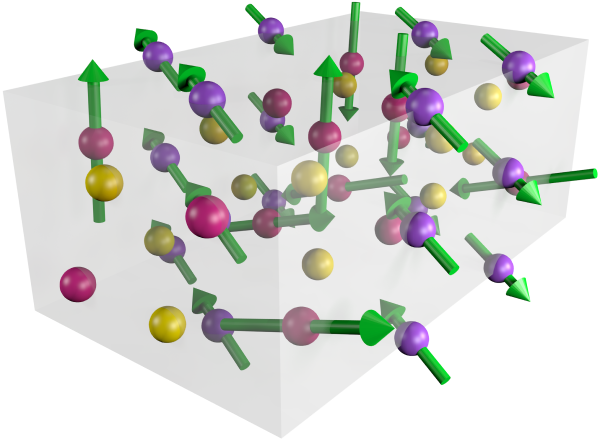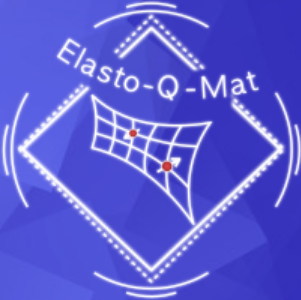Exploring materials for future spintronics
Magnetoelectronic transport properties of noncollinear antiferromagnets
 Antiferromagnetic materials with a noncollinear magnetic structure play a vital role in the emerging field of antiferromagnetic spintronics. For instance, in contrast to what one might expect, these materials can exhibit a large anomalous Hall effect despite a tiny magnetization arising from an intrinsic property of the electronic band structure and from breaking certain symmetry relations. Currently, we are investigating the electronic transport properties and microwave absorption of various Mn-based compounds to unravel the coupling between the magnetic and crystalline structure under mechanical strain.
Antiferromagnetic materials with a noncollinear magnetic structure play a vital role in the emerging field of antiferromagnetic spintronics. For instance, in contrast to what one might expect, these materials can exhibit a large anomalous Hall effect despite a tiny magnetization arising from an intrinsic property of the electronic band structure and from breaking certain symmetry relations. Currently, we are investigating the electronic transport properties and microwave absorption of various Mn-based compounds to unravel the coupling between the magnetic and crystalline structure under mechanical strain.
Phase transitions associated with magnetic-field induced topological orbital momenta in a non-collinear antiferromagnet. Deng, S.; Gomonay, O.; ChenJ.; Fischer G.; He L.; Wang, C.; Huang, Q.; Shen F.; Tan Z.; Zhou R.; Hu Z.; Šmejkal L.; Sinova J.; Wernsdorfer W.; Sürgers C. Nature Communications 15:822 (2024) https://doi.org/10.1038/s41467-024-45129-x
Spininjection and spinmanipulation in CMOS-compatible heterostructures
In this cooperative project between the Physikalische Institut (PHI) at KIT and the Institute of Semiconductortechnology (IHT) at the University of Stuttgart we aim to demonstrate spininjection, -detection and –manipulation in CMOS-compatible devices. The project was supported by the Deutsche Forschungsgemeinschaft (DFG) until 2020.
Detecting mechanical strain by NV-center spectroscopy
 We propose to implement a new experimental technique based on optically detected nitrogen-vacancy (NV) color centers in diamond. We will extend this method by application to two-phase heterostructures comprising a metallic thin film deposited on a diamond membrane containing NV centers located close to the film/membrane interface. By this approach we will be able to sense the local intrinsic strain of the film by optical read-out of the NV-center energy states. The power of this method will be demonstrated by investigating metallic antiferromagnets with non-collinear spin arrangements currently investigated in our group. The project was part of the collaborative research center TRR288 "Elastic Tuning and Response of Quantum Phases of Matter" (Frankfurt - Karlsruhe - Mainz) supported by the DFG since 2020.
We propose to implement a new experimental technique based on optically detected nitrogen-vacancy (NV) color centers in diamond. We will extend this method by application to two-phase heterostructures comprising a metallic thin film deposited on a diamond membrane containing NV centers located close to the film/membrane interface. By this approach we will be able to sense the local intrinsic strain of the film by optical read-out of the NV-center energy states. The power of this method will be demonstrated by investigating metallic antiferromagnets with non-collinear spin arrangements currently investigated in our group. The project was part of the collaborative research center TRR288 "Elastic Tuning and Response of Quantum Phases of Matter" (Frankfurt - Karlsruhe - Mainz) supported by the DFG since 2020.
Experimental methods
- Thin film and multilayer deposition (various methods)
- Electron diffraction, x-ray diffraction, magneto-optical spectroscopy
- Electronic transport measurements (resistivity, Hall effect, Nernst effect, electric-field effect) at low temperatures and in magnetic fields
Recent Publications
Ahmed, S. L.; Harsch, L.; Imre, C.; Karapatzakis, I.; Kussi, L.; Resch, J.; Schrodin, M.; Häusler, I.; Wagner, T.; Koch, C. T.; Sürgers, C.; Wernsdorfer, W.
2025. ACS Nano, 19 (41), 36302–36312. doi:10.1021/acsnano.5c09221
Huang, W.; Greule, P.; Stark, M.; Slageren, J. van; Sürgers, C.; Wernsdorfer, W.; Sangiovanni, G.; Wolf, C.; Willke, P.
2025. ACS Nano, 19 (1), 1190–1197. doi:10.1021/acsnano.4c13172
Huang, W.; Au-Yeung, K. H.; Greule, P.; Stark, M.; Sürgers, C.; Wernsdorfer, W.; Robles, R.; Lorente, N.; Willke, P.
2025. Nature Communications, 16 (1), 8242. doi:10.1038/s41467-025-63574-0
Huang, W.; Stark, M.; Greule, P.; Au-Yeung, K. H.; Sostina, D.; Reina Gálvez, J.; Sürgers, C.; Wernsdorfer, W.; Wolf, C.; Willke, P.
2025. Nature Communications, 16 (1), 5208. doi:10.1038/s41467-025-60409-w
Weißhaupt, D.; Sürgers, C.; Bloos, D.; Funk, H. S.; Oehme, M.; Fischer, G.; Schubert, M. A.; Wenger, C.; Slageren, J. van; Fischer, I. A.; Schulze, J.
2024. Semiconductor Science and Technology, 39 (12), 125004. doi:10.1088/1361-6641/ad8d06
Suergers, C.; Fischer, G.; Deng, S.; Hu, D.; Wang, C.
2024. Journal of Physics: Materials, 7, Article no: 045004. doi:10.1088/2515-7639/ad71f5
Karapatzakis, I.; Resch, J.; Schrodin, M.; Fuchs, P.; Kieschnick, M.; Heupel, J.; Kussi, L.; Sürgers, C.; Popov, C.; Meijer, J.; Becher, C.; Wernsdorfer, W.; Hunger, D.
2024. Physical Review X, 14 (3), Art.-Nr.: 031036. doi:10.1103/PhysRevX.14.031036
Althuon, T.; Cubaynes, T.; Auer, A.; Sürgers, C.; Wernsdorfer, W.
2024. Communications Materials, 5, Article no: 5. doi:10.1038/s43246-023-00439-3
Deng, S.; Gomonay, O.; Chen, J.; Fischer, G.; He, L.; Wang, C.; Huang, Q.; Shen, F.; Tan, Z.; Zhou, R.; Hu, Z.; Šmejkal, L.; Sinova, J.; Wernsdorfer, W.; Sürgers, C.
2024. Nature Communications, 15 (1), Article no: 822. doi:10.1038/s41467-024-45129-x
Sürgers, C.; Fischer, G.; Campos, W. H.; Hellenes, A. B.; Šmejkal, L.; Sinova, J.; Merz, M.; Wolf, T.; Wernsdorfer, W.
2024. Communications Materials, 5, Article no: 176. doi:10.1038/s43246-024-00617-x
Funk, H. S.; Kern, M.; Weißhaupt, D.; Sürgers, C.; Fischer, I. A.; Oehme, M.; Slageren, J. van; Schulze, J.
2022. Journal of magnetism and magnetic materials, 546, Art.-Nr.: 168731. doi:10.1016/j.jmmm.2021.168731
Zakeri, K.; Wettstein, J.; Sürgers, C.
2021. Communications Physics, 4 (1), Artikel Nr.: 225. doi:10.1038/s42005-021-00729-7
Weisshaupt, D.; Funk, H. S.; Surgers, C.; Fischer, G.; Oehme, M.; Schwarz, D.; Fischer, I. A.; Slageren, J. van; Schulze, J.
2021. 44th International Convention on Information, Communication and Electronic Technology (MIPRO), Opatija, Croatia, 27 Sept.-1 Oct. 2021, 45–49, Institute of Electrical and Electronics Engineers (IEEE). doi:10.23919/MIPRO52101.2021.9596924
Weißhaupt, D.; Funk, H. S.; Kern, M.; Dettling, M. M.; Schwarz, D.; Oehme, M.; Sürgers, C.; Slageren, J. van; Fischer, I. A.; Schulze, J.
2021. Journal of physics / Condensed matter, 33 (8), 085703. doi:10.1088/1361-648X/abcb68
Miyamachi, T.; Sürgers, C.; Wulfhekel, W.
2021. Applied physics express. Letter, 14 (11), Art.Nr. 115504. doi:10.35848/1882-0786/ac2a56
Deng, S.; Heid, R.; Bohnen, K.-P.; Wang, C.; Sürgers, C.
2021. Physical Review B, 103 (13), Art.-Nr. 134439. doi:10.1103/PhysRevB.103.134439
Deng, S.; Kraft, R.; Fischer, G.; Sürgers, C.
2020. Applied physics letters, 117 (26), 262402. doi:10.1063/5.0033683
Kraft, R.; Srichandan, S.; Fischer, G.; Sürgers, C.
2020. Journal of applied physics, 128 (3), 033905. doi:10.1063/5.0014815
Friedrich, F.; Winkel, P.; Borisov, K.; Seeger, H.; Sürgers, C.; Pop, I. M.; Wernsdorfer, W.
2019. Superconductor science and technology, 32 (12), 125008. doi:10.1088/1361-6668/ab4918
Funk, H. S.; Kern, M.; Weisshaupt, D.; Sürgers, C.; Fischer, I.; Oehme, M.; Slageren, J. van; Schulze, J.
2019. ECS transactions, 93 (1), 101–104. doi:10.1149/09301.0101ecst
Deng, S.; Fischer, G.; Uhlarz, M.; Wosnitza, J.; Bohnen, K.-P.; Heid, R.; Wang, C.; Sürgers, C.
2019. Advanced functional materials, 29 (37), Article No.1900947. doi:10.1002/adfm.201900947
Diesch, S.; Machon, P.; Wolz, M.; Sürgers, C.; Beckmann, D.; Belzig, W.; Scheer, E.
2018. Nature Communications, 9 (1), Article no 5248. doi:10.1038/s41467-018-07597-w
Sürgers, C.
2018. Nature Electronics, 1, 154–155, Nature Research. doi:10.1038/s41928-018-0047-7
Deng, S.; Fischer, G.; Srichandan, S.; Wang, L.; Wang, C.; Sürgers, C.
2018. Advanced electronic materials, 4 (9), Art.-Nr.:1800028/1–6. doi:10.1002/aelm.201800028







 orcid.org/0000-0002-2132-9775
orcid.org/0000-0002-2132-9775